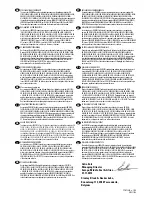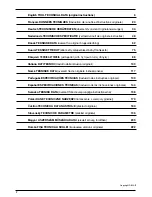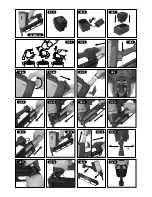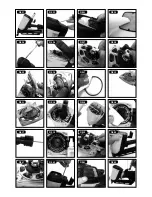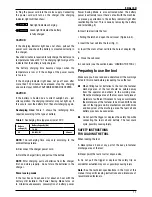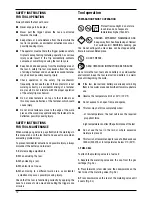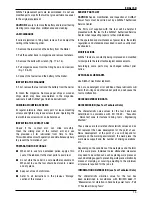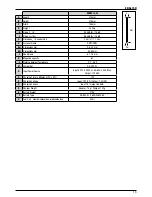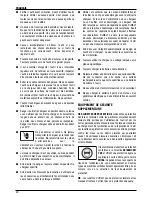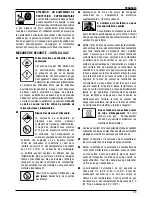
temperatures exceeding 50°C (120°F). The fuel cell
and/or battery may burst, releasing flammable gas. Do
not pierce or burn the container, even after use. Do not
incinerate, refill, reclaim or recycle the fuel cell. Do not
spray on to a naked flame or any incandescent material.
Keep away from ignition sources –
no
smoking
. Keep out of reach of children.
l
Make sure you read and follow the
instructions in ‘Additional Safety Equipment’ detailed
above.
l
Only use outside or in well ventilated
areas.
This tool exhausts carbon monoxide
which are a danger to health when inhaled. This tool
must not be used in enclosed or poorly ventilated
areas. Do not inhale.
l
Before using the power tool, check the contact arm.
The contact arm and chamber work in conjunction for
this device to operate. Before using the power tool,
make sure that the contact arm operates properly.
Without nails, fuel cell and battery loaded into the
power tool, check the following- pull the magazine
feeder latch back to disengage the nail lockout and,
with the device facing upward, press down the contact
arm then confirm that the it securely returns to
its original position. If the contact arm operates
abnormally, do not use the power tool until it has been
inspected and repaired. The contact arm operation
becomes especially heavy in low temperatures and
drive operations may not function. When pulling back
the feeder knob, the contact arm must move smoothly.
Furthermore, the contact arm must never be modified
or removed.
l
Do not touch around the exhaust
outlet.
This tool produces hot exhaust gases
that may ignite flammable materials. The contact
arm and nose will become hot when in use and get
hotter after prolonged or rapid use. Do not touch
with bare hands.
l
Disconnect the battery and fuel cell and take out any
nails left in the magazine after use. Disconnect the
battery and fuel cell from the tool before doing tool
maintenance, cleaning a jammed fastener, leaving the
work area, moving the tool to another location, or after
use. It is very dangerous if a nail is fired by mistake.
l
The operating environment for this device is between
0°C (32°F) and 40°C (104°F) so ensure that use is
within this temperature range. The device may fail to
operate below 0°C (32°F) or above 40°C (104°F).
l
Always charge the battery at an ambient temperature
of 0–40°C.
l
A temperature of less than 0°C will result in over
charging, which is dangerous. The battery cannot be
charged at a temperature greater than 40°C. The most
suitable temperature for charging is that of 20–25°C.
l
Do not use the charger continuously. When one charge
is complete, leave the charger for about 15 minutes
before beginning the next charge.
l
Do not allow foreign matter to enter the hole where the
rechargeable battery fits.
l
Never disassemble the rechargeable battery or charger.
l
Never short-circuit the rechargeable
battery.
Short-circuiting the battery will
cause a great electric current and the battery will
overheat. This will result in the burning of, or damage
to the battery.
l
Do not dispose of the battery in fire. If the battery is
burnt, it may explode.
l
Using an exhausted battery will damage the charger.
l
As soon as the post-charging battery life becomes too
short for practical use, recycle according to your local
legislation.
l
Do not insert objects into the air ventilation slots of the
charger. Inserting metal or flammable objects into the
charger’s air ventilation slots will result in an electrical
shock hazard or damage to the charger.
l
Do not inhale its contents.
In case of
inhalation, the person affected should
be taken into the open air and brought
into a comfortable position.
l
Expanding gases cause low temperatures. Fluid gases
might cause injuries when coming into contact with
skin or eyes. In case of contact with skin, wash the
contact surface carefully with warm water and soap
and apply a skin cream when dry. In case of contact
with eyes, rinse the open eyes under running water.
Contact a doctor if necessary.
l
Store fuel cells in a well ventilated area.
Do not store above 50°C (120°F) (for example in direct
sunlight or in a vehicle). Do not expose to an open
flame and sparks. Do not puncture or open the fuel cell.
Do not refill, reclaim or recycle the fuel cell. Dispose of
according to local regulations for aerosol products. Do
not dispose of fuel cell with other scrap for recycling.
Keep out of reach of children.
ENGLISH
9
Summary of Contents for DGN9033-XJ
Page 2: ...DGN9033 XJ ...
Page 4: ...3 ...

